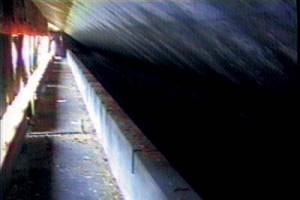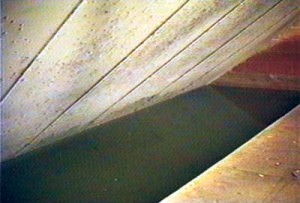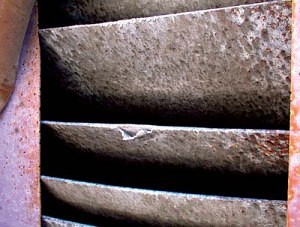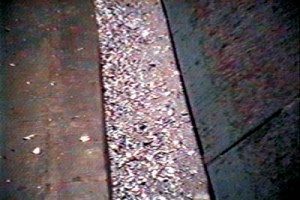Month: April 2013
Bullet Trap Comparisons, Pt. 1
For many years, bullet trap technology has been mired in confusion, misunderstanding, and misinformation. The various approaches to bullet containment and disposal have become as diverse as they are numerous. The purpose of this article is to provide accurate information and valuable education by examining various bullet trap theories, technologies, and applications in an objective manner.
The following information represents the views and opinions of Action Target based on our experience and observations. You are encouraged to conduct your own research and speak with other users about their experiences with the various bullet trap technologies presented.
Sand Berm
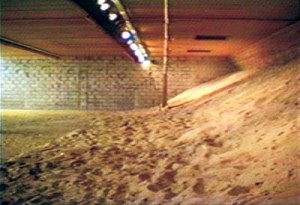 The sand or dirt berm is the oldest and most basic type of bullet trap. It uses the mass of the berm itself to stop and store bullets, and on outdoor ranges it can literally be the side of a mountain. On indoor ranges however, some type of structure or barricade is used to support the berm and hold back the sand.
The sand or dirt berm is the oldest and most basic type of bullet trap. It uses the mass of the berm itself to stop and store bullets, and on outdoor ranges it can literally be the side of a mountain. On indoor ranges however, some type of structure or barricade is used to support the berm and hold back the sand.
On ranges where qualification or other events where tightly grouped shooting patterns are common, concentrations of lead called hot spots can form behind the targets causing subsequent shots to ricochet and bounce back toward the shooter. In order to recover spent bullets, the berm must be mined and the lead separated out. A certain amount of the sand will be contaminated and must be replenished each time the trap is cleaned. Sand and dirt berms are coming under increasingly harsh environmental scrutiny due to high lead levels in the ground around the trap and the tendency of the lead to seep into surrounding ground water.
The benefits of a sand berm include low cost, relatively low maintenance, and the ability to use any kind of ammunition.
Weaknesses include potential environmental hazards, expensive mining, and hot spot ricochet.
Pit and Plate Trap
With this application, a steel plate is used to redirect bullets into a bed of sand. The steel is often called a “smash” plate because the acute angle—in this case, anything greater than 25 degrees—causes bullets to smash into small pieces on impact before they are scattered on the sand below.
Because the lead fragments rest mostly on top of the sand, this trap must be cleaned frequently by mining the lead from the sand and disposing of it properly. Under moderate to heavy use, a thick lead build-up can develop in the back corner of the trap causing bullets to be deflected back toward the shooter.
The benefits of a pit and plate trap include lower initial cost and simple installation.
Weaknesses include bullet fragmentation on impact, lead build-up, ricochet, and high maintenance.
Water and Plate Trap
The water and plate trap is similar to the pit and plate trap, except the sand is replaced by a large trough of water. Bullets still fragment into small pieces after impacting the smash plate, but with this system, they splash into the water and sink to the bottom of the trough. To retrieve the lead, you must shovel or scoop it from the water and dispose of it properly. The water in the trough must be replenished due to evaporation, and the evaporation can cause increased humidity on your range and problems with your ventilation system.
The benefits of a water and plate trap include lower lead dust levels and no ricochet off other bullets.
Weaknesses include bullet fragmentation on impact, maintenance of the water, and the limitation to indoor use only.
Venetian Blind Trap
This older application uses a series of angled steel smash plates to redirect bullets to the back and bottom of the trap. Some versions of this trap have the smash plates mounted loosely to help absorb some of the bullets’ energy, but the acute angle of the plates can still cause significant fragmentation. To keep bullet splatter from bouncing back at the shooter, rubber curtains are often mounted across the entire face of the trap.
Because rubber is destroyed every time you shoot into it, these curtains must be replaced or patched frequently to maintain their effectiveness.
The benefits of a venetian blind trap include the durability of steel, no sand or granules, and a small floor space requirement.
Weaknesses include bullet fragmentation on impact, splatter and ricochet, no close-range shooting, and maintenance of the rubber curtains.
Escalator Trap
This is another old-fashioned steel trap that uses steeply angled smash plates to stop bullets and direct the fragments to an open collection area. Some manufacturers recommend that the impact plates be coated with oil to provide lubrication and reduce fragmentation. This oil can be washed away into the surrounding soil if the trap is not protected from the elements in outdoor applications.
The same system of protective rubber curtains may also be necessary with this trap due to the acute angle of its steel smash plates.
The benefits of an escalator trap include the durability of steel and no sand or rubber granules.
Weaknesses include bullet fragmentation on impact, no close-range shooting, maintenance of the rubber curtains, and poor lead storage and collection.
Rely on the Experts for Help
There are hundreds of things to take into consideration when building a shooting range, but your top priority should always be safety. Before anything else, make sure your range is going to be safe for your customers, your employees, and the environment. If you are considering building a range, talk to the Action Target representative in your region and he will be happy to help you find the right equipment to fit your needs and budget.
Shoot Houses and Shoot House Training
By Bob Schneider
I was first introduced to live fire shoot house training in 1986 at the world famous Gunsite Academy in northern Arizona. I had already been a Denver, Colorado, police officer for more than 10 years and was then a member of its full-time special weapons and tactics team (SWAT). Prior to transferring to SWAT, I was a patrol officer assigned to the northeastern quadrant of the city and county of Denver.
As a police officer, I had to search many businesses after silent alarms had been tripped as well as respond to calls that put me inside someone’s house. I had been trained to conduct building searches and how to handle calls inside structures, but I had not been exposed to firing live ammunition in that training arena. Was I sufficiently trained to conduct such police actions? I believed I was, but my eyes were opened to a higher level of training that my department had not exposed me to.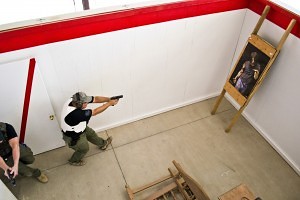
In 1993, my department received a civil judgment against it for not providing adequate training to its police officers. My department had not provided “periodic target course shoot/don’t shoot live training under street conditions, particularly for officers on the front line.”1 We had required our officers to qualify once a month (later changed to quarterly) on a live fire course on a square range. This traditional range is exactly the same as all firearms ranges in the country used for law enforcement qualification and training. But our qualification courses did not require decision making, had little to no movement by the shooter, and was performed under adequate lighting conditions. The qualification target would turn and face the shooter which initiated the officer to present his/her weapon and fire the required number of rounds into the target before it edged away. This is the standard for all law enforcement agencies in the country. Then, some type of score is given for the officers’ records. If the officer passed, no further action was required. No additional training was given.
We know today that periodic qualification is just the beginning for our officers’ records. Continuing education is required in subject areas such as changes in the law or department regulations relating to the use of force, other options available other than the use of deadly force, and the list goes on. We now know we have a responsibility and obligation to expose our officers in training to as many situations as possible that they may encounter on the street.
If you believe you do have a responsibility and obligation to train your officers to the highest possible level, and your officers may find themselves in a structure like a building or house or business, then you need a live fire shoot house.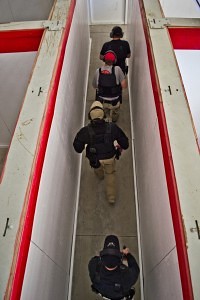
Historically, live fire shoot houses have been made out of old automobile tires, plywood, cinder blocks, and other material that stops bullets. My SWAT team even made portable bullet traps that allowed us to make any building into a live fire shoot house. With today’s modern technology in clean ammunition and live fire shoot house construction, we have no excuse not to train our officers in live fire indoor simulators.
Companies such as Action Target make an excellent portable bullet trap![]() . Its design and construction allow law enforcement agencies to tailor a structure to their environmental and economic needs.
. Its design and construction allow law enforcement agencies to tailor a structure to their environmental and economic needs.
I call it the “pay now or pay later” program. You can either pay now to build an indoor live fire simulator or you can pay later for not providing this level of training to your officers. You make the decision. If it was my decision, I would pay now. I would play every possible card in my deck to get a live fire shoot house.
Contact Action Target for options about getting your shoot house. I am confident that they will help you with your needs.
About Bob Schneider
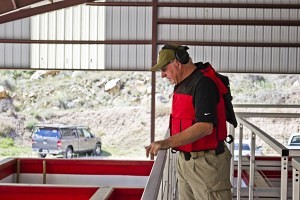
Bob Schneider retired from the Denver, Colorado, Police Department after 21 years of service. He spent 18 years assigned to his department’s full-time special weapons and tactics team. He is a certified firearms and less-lethal weapons instructor and has taught classes to federal, state, and local law enforcement officers as well as to U.S. and foreign military units here and overseas. Bob has developed several firearms and tactics courses to include training scenarios that are being used by popular simulator manufacturers. He currently lives in Denver, Colorado, with his two sons, Dylan and Jake.
The views and opinions expressed in this article are those of the author and do not necessarily reflect the official position of Action Target as a company.
1. Zuchel v. City and County of Denver, Colo., 997 F. 2d 730 – Court of Appeals, 10th Circuit 1993.
Action Target Builds its First Shooting Range in South America
The PCERJ range in Rio de Janeiro, Brazil, marks a milestone for Action Target’s growing international program
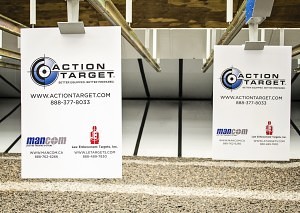
PROVO, Utah – April 9, 2013 – Action Target recently installed a new shooting range in Brazil for the State Civil Police of Rio de Janeiro (PCERJ). This is the first range built by Action Target in South America and marks a milestone for the company as it continues to branch into international markets.
“Opening the doors to South America was a big step for us,” Action Target’s Director of International Business Development Adam White said. “I think the Brazilian government understands training facilities of this kind are essential for progressive, effective training, and we hope to continue to work with them in the future.”
The new range was purchased by the PCERJ in a push to increase training standards for state and local law enforcement, but will also support training for special operations units from other states around Brazil as well. It features an open air 11-lane shooting range with user-friendly target retrieval systems from Mancom and a nine-room shoot house facility. To ensure bullet containment, the new range also includes a steel funnel bullet trap and safety baffles which provide ballistic protection for the shooting area.
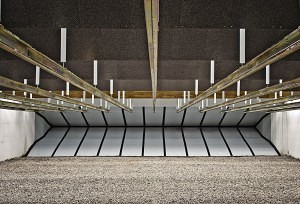
“There is no roof on the range to allow for natural ventilation, but the safety baffles we installed also make sure no rounds have the chance to escape,” White said.
One aspect of the range that is especially important to the Brazilian government is its effect on the environment. The PCERJ range utilizes technology from Action Target to ensure lead dust and debris are safely contained and collected for recycling.
As a bullet strikes the armor steel plate of the Total Containment Trap (Action Target’s patented steel funnel bullet trap), it is forced through the small horizontal opening in the middle of the funnel.
Once it has passed through the opening, the bullet enters the deceleration chamber where it spins until it loses energy. The bullet then falls into a trough where it is funneled into one of many plastic canisters.
“The canister lead collection system is simple but extremely effective,” White said. “Once the canisters (which are just 5-gallon buckets) get about two-thirds of the way full, you can just pop it off, put a lid on it, and it’s ready to be recycled. None of the range personnel ever have to come in direct contact with the lead, and it’s easy to maintain.”
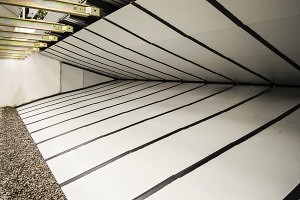
The threat of lead dust created by the impact of the bullet is also eliminated through a Dust Collection Unit which uses negative pressure to pull dust and air-borne toxins toward the rear of the bullet trap where it enters a filtering system. This system removed 99.98% of lead and other materials before the air is released into the environment.
Brazilian officials are also grateful for the safety the new range will provide officers during training situations. The old facility often used wood as backstops for shooting drills and presented a significant ricochet danger for trainees.
The new range allows for nearly limitless use of tactical weapons from handguns to fully automatic rifles with complete containment. That assurance makes for a healthy environment where law enforcement trainers can push officers to the limit without putting them in harm’s way.
And Rio de Janeiro’s law enforcement officers will certainly be pushed to the limit as they run intensive tactical drills in the new nine-room Modular Armored Tactical Combat House (MATCH). Equipped with a catwalk and ballistic walls, law enforcement teams can now practice essential close quarter skills like room clearing and hallway navigation with live fire weapons while under close watch from above.
The PCERJ range’s grand opening will be held at the end of June when it becomes fully functional as a law enforcement training facility, but tours have been ongoing for those attending the LAAD Defence and Security International Exhibition held this week in Rio de Janeiro.
The Truth About Steel and Steel Targets
With more and more companies and individuals manufacturing steel targets, the water has become increasingly muddy where accurate information is concerned. With technical data provided by the American Iron and Steel Institute in Washington D.C., this report is designed to cut through the recent hype and establish a basis of fact for accurate evaluation and comparison.
What Is Steel?
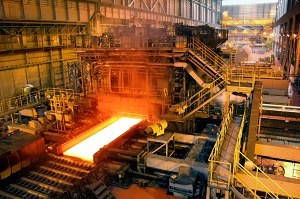 Steel is an alloy metal composed of iron and varying amounts of carbon and/or other elements such as chromium, nickel, tungsten, manganese, and so on. Steel with specific properties and characteristics is created by adjusting the overall chemical composition or by altering the various production processes such as rolling, finishing, and heat treatment. Because each of these factors can be modified, there is potentially no limit to the number of different steel recipes that can be created. Currently, there are over 3,000 catalogued grades or chemical compositions of steel available. Steel can utilize a wide variety of alloying elements and heat treatments to develop the most desirable combination of properties.
Steel is an alloy metal composed of iron and varying amounts of carbon and/or other elements such as chromium, nickel, tungsten, manganese, and so on. Steel with specific properties and characteristics is created by adjusting the overall chemical composition or by altering the various production processes such as rolling, finishing, and heat treatment. Because each of these factors can be modified, there is potentially no limit to the number of different steel recipes that can be created. Currently, there are over 3,000 catalogued grades or chemical compositions of steel available. Steel can utilize a wide variety of alloying elements and heat treatments to develop the most desirable combination of properties.
Steel Hardness and Quality
For steel targets to be functional and safe, they should be made of high quality through hardened steel that has a Brinell hardness number (BHN) of at least 500. The steel must also provide sufficient strength, toughness, and impact resistance. The Brinell hardness test depends upon the resistance offered to the penetration of a carbide steel ball (1.6 mm diameter) when subjected to a weight of 12.6 kg. The resulting hardness value is computed as the ratio of the applied load to the area of the indentation produced. This test is accepted as a worldwide standard for measuring the hardness of steel.
Truth – There are 2 Factors that Affect the Hardness of Steel
The first is the amount of carbon and other alloying elements in its chemical composition, and the second is the manner in which the heating and cooling of the steel is manipulated. These factors are determined at the most fundamental level, and affect the finished steel as a whole.
Truth – Steel Hardness is a Critical Issue
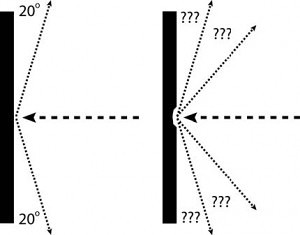
training environment.
There are many steel mills located around the world, but only a select few are able to produce steel that is hard enough and of sufficient quality to be safely used for steel targets and equipment. Action Target has a list of major producers of Steel that meet quality specifications. Each of these companies may have minor proprietary differences in their production methods, but they all must make sheets of hard steel in essentially the same way. Nevertheless, some suppliers of targets and shooting range equipment attempt to muddy the water and create perceived differences in steel quality where none exist. One particularly misleading claim refers to a certain company’s use of through hardened steel as opposed to merely surface hardened AR500 steel allegedly used by everyone else. We state the following with all possible force:
1. Action Target uses only high quality, through hardened steel with a Brinell hardness rating of at least 500, and we use it in every one of our ballistic steel products.
2. Action Target can also provide through hardened steel targets and other steel products with certified Brinell hardness ratings of 550 and even 600.
3. Despite the inaccurate claims, AR500 steel is NOT surface hardened. It is through hardened. Witness the quotes listed below from steel suppliers around the country.
Chapel Steel – AR500 is a quenched & tempered, through hardened, wear-resistant grade of abrasion resistant steel plate used for severe impact. (SOURCE: https://www.chapelsteel.com/ar500-ar500f.html)
Heflin Steel – Heflin REM 500 abrasion resistant plate is a premium grade wear plate, ideal for extreme abrasion coupled with resistance to impact. REM 500 plate is through hardened up to a 3″ thickness for maximum hardness and abrasion resistance.
Benco Steel – AR500 is a through hardened steel with high hardness for use where there is severe impact and abrasion.
(These companies are steel suppliers, not manufacturers or producers. They buy steel from the actual manufacturers like HARDOX / SSAB, and then re-sell it to their own customers.)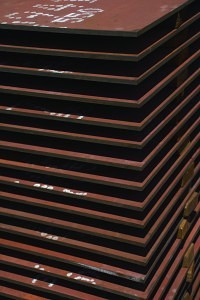
4. Any statements contrary to those above are simply untrue.
Be careful not to get caught up in the “more is better” mindset. Just because a Brinell hardness number (BHN) of 500 is good, it doesn’t mean a rating of 700 is better. While you must use steel that is hard enough for the task, going overboard only impacts your checkbook and not the product durability. For example, ballistic tests have shown that the performance difference between steel with a 500 BHN and steel with a 535 BHN is so small that you can’t tell the difference with a bullet but only with a gauge. Also be aware that you can actually use steel that is too hard and too brittle for ballistic training purposes.
</ br>
Shop All Our Steel Targets







